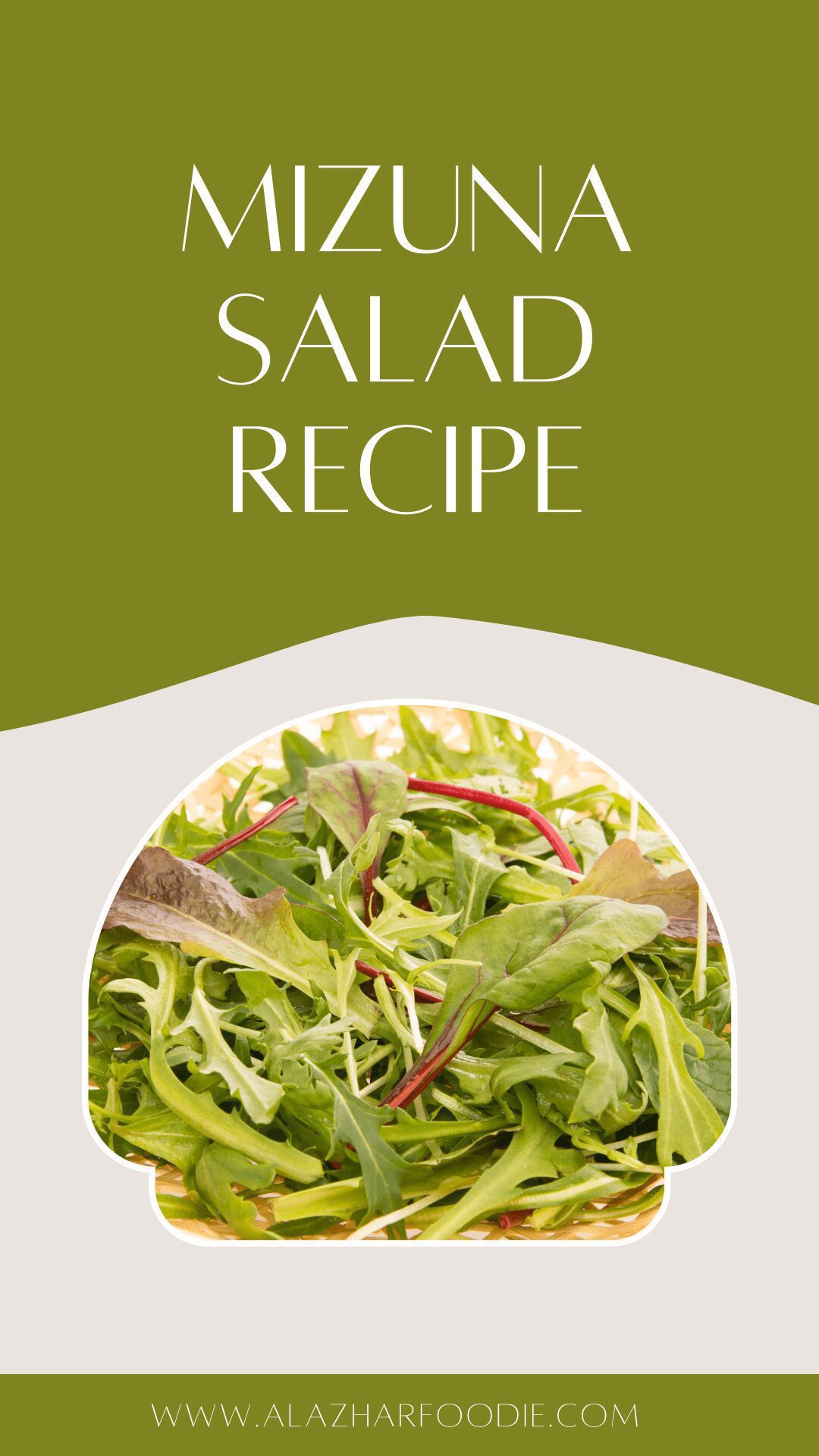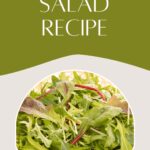Mizuna Salad Recipe
Topic: Mizuna Salad Recipe

Mizuna Salad Recipe
How Do You Describe MIZUNA LEAVES?
Brassica Rapa, often known as Mizuna, is a mustard-family leafy green. It’s also known as Japanese mustard greens, spider mustard, or a combination of the two.
If you’re acquainted with the term “brassica,” you know that Mizuna is related to other cruciferous vegetables, such as broccoli, cauliflower, and Brussels sprouts.
Merely like kale greens, it’s just on the leafier end of the spectrum when it comes to its categorization. Tender, medium-sized, fast-growing, and grows in bunches (I grew it last year in my garden with minimal effort at all).
Mizuna lettuce’s highly serrated leaf margins are undoubtedly its most distinctive characteristic. Serrated edging gives it a virtually identical appearance to dandelion greens.
How Do You Say “MIZUNA LETTUCE”
Brassica Rapa, often known as Mizuna, is a mustard-family leafy green. It is sometimes referred to as Japanese mustard greens or Spider Mustard to distinguish it from other varieties.
Many other cruciferous vegetables in the genus “brassica” include broccoli, Brussels sprouts, and cauliflower. This indicates that Mizuna is also related to these other vegetables. Simply like kale greens, it’s just on the leafier side of things.
It’s a medium-sized sensitive green that grows in clumps and spreads quickly (I grew it last year in my garden with minimal effort at all).
Mizuna lettuce’s steep serrated leaf margins are undoubtedly its most distinctive trait. Serrated edging gives it a virtually identical appearance to dandelion greens.
MIZUNA’S NUTRITIONAL ADVANTAGES
While they may not be as well-known as kale, mizuna greens are cruciferous vegetables that can’t be beaten for nutritional value. Vitamins A and K and minerals like folate and iron are abundant in this food, which is low in calories.
Quercetin, beta carotene, and the lesser-known anticancer, antioxidant kaempferol, are all abundant in this vegetable, as are many others.
Mizuna Salad Recipe
PrintMizuna Salad Recipe
Allowing the lettuce to take centre stage.
When it comes to taste, this salad’s dressing is the star of the show. It’s so simple and delicious that I can guarantee you’ll be preparing it often.
- Prep Time: 10
- Total Time: 10 minutes
- Yield: 2 1x
- Category: Salads
- Cuisine: American
- Diet: Vegan
Ingredients
Salad Ingredients:
- Wash, dry, and coarsely slice a big bunch of mizuna.
- 1/2 a Honeycrisp apple, a tart-sweet variety, is sliced into matchsticks.
- A handful of raisins.
- Seeds of sunflowers
Salad Seasoning Ingredients:
- Extra virgin olive oil is the purest kind of olive oil.
- Lemon juice that has just been squeezed.
- It’s a good one.
- Vinegar is made from apples and pears.
- Honey.
- A touch of salt and a bit of spice.
That is all that is required in the mizuna dish.
Instructions
- The MIZUNA SALAD IS EASY TO MAKE
- Add chopped mizuna lettuce, apple slices, raisins, and sunflower seeds to a large salad dish.
- In a separate small dish or container, combine all dressing ingredients and pour over the salad before serving.
- Turn to coat each piece of mizuna well.
- The lettuce should be seasoned well before dishing.
- You can prepare both the salad and the dressing ahead of time and store them separately.
Nutrition
- Serving Size: 1
- Calories: 396
- Sugar: 29g
- Sodium: 643g
- Fat: 23g
- Saturated Fat: 5g
- Unsaturated Fat: 16g
- Trans Fat: 0
- Carbohydrates: 47g
- Fiber: 9g
- Protein: 6g
- Cholesterol: 11mg
Keywords: mizuna salad recipe, mizuna apple salad recipe, what is mizuna salad
IS MIZUNA Flavourful Wonderful?
This lettuce has a distinct flavour.
With milder lettuce greens (such as romaine, red leaf, etc.) and spinach on one side, it’s in the midst of a flavour spectrum that includes mustard greens and Arugula.
Mizuna lettuce’s place on the lush green spectrum is one of the reasons I like it so much.
While it has enough individuality to stand out on its own in a salad like this, the bitterness doesn’t become so overwhelming that you need a lot of other components to mask it (which is sort of how I feel about endive or radicchio).
Cooked dishes, such as this spicy tofu soup or stir fry, may also benefit from the addition of Mizuna. It’s more than simply a vegetable.
This salad, which has crunchy tart-sweet apple slices and sweet raisins, showcases the Mizuna’s wonderfully balanced taste.
Everything comes together in a sweet and tangy honey lemon dijon dressing that will have you seeking mizuna lettuce on your next shopping trip.
While the apples in this mizuna salad dish could imply a more autumnal feeling, I believe Honeycrisp apples are a year-round fruit.
I can’t say that about all apples, but this particular variety, with its delightfully juicy tart sweetness, makes me feel that way.
However, if you prefer a more in-season fruit, feel free to substitute apples.
Any stone fruit, such as plums, nectarines, cherries, or peaches, would go well with the mizuna greens and honey lemon dijon dressing.
People Also Ask:
What is the mizuna plant?
Commercial salad mixes often include the mild Japanese mustard known as Mizuna. The leaves are green and lobbed, and the flavour is pleasantly bitter. As a relative of the turnip, Mizuna has a unique taste. When harvested as a cut-and-come-again green, it grows beautifully and is quite simple to cultivate.
Is mizuna lettuce?
Brassica rapa, often known as Mizuna, is a mustard-family leafy green. It’s also known as Japanese mustard greens or spider mustard in various country regions. Mizuna lettuce’s steep serrated leaf margins are undoubtedly its most distinctive trait.
What is the English name for Mizuna?
Many other names for Mizuna include Japanese mustard, Shui can (literally, “water greens”), and California peppergrass. Mizuna has a moderate peppery flavour that mixes Arugula and mustard. The shiny surface and smooth serrated edges give the green a lovely sheen.
What are the benefits of Mizuna?
- It prevents cancer cells from spreading and reduces the risk of cancer.
- To aid healing, it increases the flow of blood and ensures that healthy blood clots form.
- Bone health and strength may be improved by using this supplement.
- Immune system health is bolstered, and respiratory illnesses like pneumonia are less likely to develop.
- Reduces the likelihood of various eye problems, such as age-related macular degeneration, while also improving overall eye health.
What do mizuna greens taste like?
Mizuna has a somewhat bitter, peppery flavour that enhances fresh and cooked meals. It is often compared to arugula and mustard greens.
How do you eat Mizuna?
Pesto, salads, and pasta dishes all benefit from the spicy leaves of Arugula. Stir-fries using Mizuna are very popular, but the stems and leaves must be prepared separately since cooking durations vary.
Are mizuna flowers edible?
During the winter, you might use the leaves in salads, but now you may enjoy the flower’s incredible fragrance. All of the buds and blossoms may be eaten. Prepare salads or stir-fries with them to see how they taste.
How long does Mizuna take to grow?
Cool temperatures are ideal for Mizuna’s growth. In mid-to late-spring, sow seeds or plant transplants so that they may be harvested before the summer heat sets in. Mizuna takes 40 days from seed to harvest when planted every three weeks.
How often do you water mizuna?
Nitrogen is released into the soil as legumes die or are tilled into the ground. Each week, Mizuna need 1 inch of water. You’ll need to water your garden if it doesn’t rain enough to keep the soil wet. Plants can’t or grow slowly if the air is too dry.
Can you grow Mizuna indoors?
Grow Mizuna with a minimum spacing of six inches for full-sized heads. Starting seeds inside four to five weeks before your final frost date is an option if wanted. Germination takes just four to eight days for most seeds. Mizuna is a relatively low-maintenance plant since it proliferates.
How to harvest Mizuna?
The best way to harvest Mizuna is with a well-balanced, precise knife. Remove the leaves from the soil by cutting them off at the base. It is possible to harvest the plants at various stages of maturity. When harvesting young greens, the plants should be between 3 and 6 inches tall, which takes roughly 20 days.
Can you freeze Mizuna?
Freezing them is a possibility. The greens should be cut to the appropriate length: The optimum size is between 1 1/2 and 2 inches, but you don’t want anything too tiny.
How do you preserve Mizuna?
- For a maximum of five days, Mizuna may be stored in the refrigerator.
- Before storing the leaves in the refrigerator, ensure they’ve been well cleaned and dried.
- Please put them in an airtight container and keep them in the fridge or freezer when you’re done.
How many types of Mizuna are there?
Mizuna comes in 16 different colour and texture variants. Temperature extremes may also be a problem for specific breeds.
Types of Mizuna:
- Kyona. This cultivar has white stocks with severely serrated leaves as thin as a pencil and as long as a pencil lead.
- Komatsuna. Developed for heat and disease resistance, this variety features dark green, rounded leaves.
- Komatsuna in red colour. Komatsuna with maroon foliage is comparable to this kind.
- Rich is in a good mood. A dark green variety with florets resembling small broccoli heads is perhaps the most unusual.
- Nutritional Green. Deep green leaves make this type more tolerant of hot and cold weather.
Can you freeze fresh greens without blanching?
Blanching the greens first is the preferred method for freezing them. Although it is not mandatory, it is possible to freeze fresh greens and other vegetables without freezing them. Pre-freezing your greens before totally freezing them is the best technique to freeze them without blanching.
Is Mizuna a rocket?
Mizuna may be eaten fresh or cooked. Nigella recommends using a rocket (roquette/roquette) found in various shops and Asian grocers as a substitute for Mizuna. Small watercress leaves may also be used as a substitute.
Is Mizuna the same as Arugula?
Live Earth Farm explains that Arugula and Mizuna are both members of the mustard family. There are specific differences between the two, including the fact that the leaves of Arugula are deeper in colour than Mizuna’s, and the stems of Arugula are green rather than white like Mizuna.
What is red Mizuna?
Mizuna Brassicaceae (the family of cabbage and broccoli) includes Red Mizuna, a hybrid variant of the Japanese heritage green.
How do you eat purple Mizuna?
Adding it to stir-fries, spaghetti, pizza, and soup will allow you to get the benefits of its flavour without having to cook it. Additionally, you may pickle it for use in grain bowls or atop sandwiches.
What is Beni Houshi mizuna?
Mizuna with mild, soft, lime-green leaves and brilliant purple stems is the new Beni Houshi mizuna. The beneficial phytonutrients in these stems are the same as those in blueberries. The greens may be used as a replacement for spinach or other greens in salads or as a garnish.
What is the rocket?
Annual plant of Brassicaceae family known for its fresh, tart, bitter, and peppery taste, known as Arugula or rocket Garden rocket and eruca are two more familiar names. It’s also known as “bruschetta,” “cola,” “cold,” among other things.
Is Mizuna an annual?
Mizuna is commonly grown as an annual salad green from seed by most gardeners. Full heads should emerge around day 40 for baby greens, harvested in around 20 days. Mizuna enjoys cold temperatures and should be planted in the spring or late summer if you live in a hot region. Can you grow Mizuna in winter?
Mizuna enjoys cold temperatures and should be planted in the spring or late summer if you live in a hot region. It may also be planted in the autumn if your winters are mild, and it should do just well without any further protection.
Are Mizuna seeds edible?
A mild, earthy, mustard-like taste characterises Mizuna’s tender leaves. Leaf stalks have a crunchy texture and a pleasant, juicy flavour. Soups, stir-fries, pizza and pasta toppings, sandwiches and burgers all benefit from their inclusion. The seed pods themselves may be consumed as well.
How do you grow Mizuna from seed?
- Sow seeds in the late spring or early autumn, six to twelve weeks before the first fall frost.
- Prepare a wet, well-draining soil for the seedlings and sow them.
- Add some manure or compost after loosening the soil to a depth of approximately 12 inches.
- After sowing the seeds, space them out 2 inches apart and water them well.
Best seeds For growing Mizuna
How long does it take for Mizuna to germinate?
Grow Mizuna with a minimum spacing of six inches for full-sized heads. Starting seeds inside four to five weeks before your final frost date is an option if wanted. Within four to eight days of planting, seeds germinate and grow. Seedlings cultivated inside for at least four weeks should be transplanted.
What is eating my Mizuna?
Although it is resistant to the common brassica illnesses, several pests find it a desirable food source. A row cover may help protect this leafy green from flea beetles, which do the most significant harm. Leaf-eating pests like whiteflies and aphids may also cause damage if left unchecked.
How do you cut Mizuna?
Prepare Mizuna by following these simple steps. Wash or submerge the stalks in many water changes and dry them after trimming a few inches from the base of the plant.




